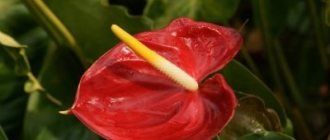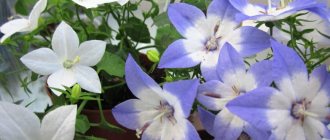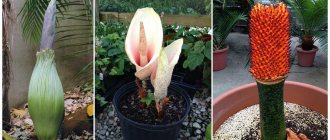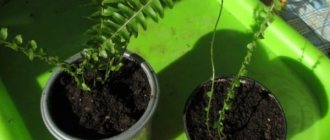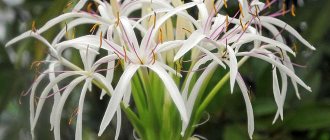What does pachistachis look like? Photo. Care
Pachistachis is a tropical plant. It is native to southern and central America and eastern India. On average there are 12 plant species. Pachistachis yellow is grown as an indoor flower. It is very rare to see red pachystachys. Home care is not difficult. The main things for him are light, warmth and humidity. And during active growth and flowering, you need to provide the plant with additional feeding.
Pachistachis has elongated dark green leaves. It attracts attention with its yellow inflorescences, reminiscent of golden ears or candles. They are often mistaken for flowers, but they are only pre-flowers. Pachistachys blooms with inconspicuous white flowers that grow perpendicular to the preflowers, and they quickly fall off. But the yellow ears last a very long time and give the plant an elegant, solemn appearance.
Where to place it?
The flower requires good lighting and warmth. The ideal location would be windows facing west or east. Pachistachis requires bright, but at the same time diffused lighting. You can place the flower on a south window, but then in the summer the plant needs to be shaded.
The most comfortable temperature in spring and summer is 20 0 C for the pachystachis flower. Care at home at temperatures above 24 0 C requires increasing the humidity. In summer, pachistachis can be taken out to the balcony and placed in the shade. In autumn and winter, it is necessary to maintain the room temperature within 16-19 0 C. Pachistachis is sensitive to drafts. It is also not advisable to place the flower near the battery.
Pachistachis requires maintaining sufficiently high humidity. For spraying, it is better to use soft water, filtered or settled. In winter, the flower needs to be sprayed every day. During flowering, you must be careful when spraying and not get it on the inflorescences.
Conditions for successful growing at home
The screw palm can be grown in different indoor environments. Indoor pandanus is unpretentious to growing conditions and can grow in almost any microclimate. But at the same time, the plant is heat-loving and does not tolerate cold drafts.
Selecting a location
Pandanus needs sunlight and a lot of free space, as it is tall and voluminous. You need to place the flower in a spacious, bright room with a high ceiling.
Recommendations for lighting and choosing a location for a spiral palm tree:
- the flower does not like extremes in lighting - direct sunlight and poorly lit places;
- the plant requires bright, diffused lighting, which has a beneficial effect on the growth of leaves and stems. Therefore, you need to place the flower near windows facing east or west;
- when the length of daylight hours decreases, the plant needs to turn on artificial lighting. A fluorescent lamp is suitable; it should be placed at a distance of 1 m from the flower. The total duration of daylight in the autumn-winter period should be at least 8 hours;
- The branches of the screw palm are constantly reaching towards the light source. To prevent the plant from becoming deformed, you need to regularly turn it with different sides towards the window or lamp;
- Pandanus needs access to fresh air, so in summer it can be taken outside. You need to place the palm tree under a canopy to protect it from direct sunlight and rain;
- Do not place the plant in a draft - this can cause yellowing of the leaves.
Air temperature and humidity
Pandanus is a heat-loving plant. In summer it needs a temperature from +20°C to +25°C, and in winter - not lower than +16°C. Small regular ventilations have a beneficial effect on the palm tree, but it should not be left in a draft.
Did you know? Local people in tropical Africa use the central veins of pandanus leaves to make baskets.
The screw palm can grow in conditions of moderate air humidity - about 60%.
You can achieve this indicator using the following actions:
if the warm room is too dry, you can spray the leaves of the plant with water
But at the same time, it is important to ensure that water does not accumulate at the base and on the surface of the leaves, as this can cause them to rot;
You can use a tray with wet expanded clay or moss. The pot with pandanus is placed on a tray so that its bottom does not come into contact with water;
to increase humidity and make palm leaves shiny, you can wipe them from dust with a slightly damp sponge
This procedure must be carried out with gloves so as not to injure your hands on the thorns. Dust should be wiped away from the base of the sheet to its edge.
Requirements for watering and fertilizing pachistachis
In summer, the plant requires abundant watering. The soil should always be moist. It is recommended to water the flower once every three days. Do not allow excess moisture, especially stagnation of water. In winter, watering must be reduced. It is necessary to moisten the soil approximately once every 2 weeks or a little more often when its top layer dries out. The soil should not be allowed to dry out.
During summer flowering it is necessary to feed Pachistachis. Home care allows you to use both mineral and organic fertilizers. The flower reacts especially well to complex flower fertilizer. Fertilizing is applied at the time of watering 1 or 2 times a month. Chicken manure or cow manure can be used as organic fertilizers. Both mineral and organic fertilizers have a good effect on the plant, so when choosing, you must be guided by personal preferences and capabilities.
Care
Even such an indestructible plant, as it is jokingly called, like pandanus, needs proper care. It is very easy and will not be difficult.
Watering and effective fertilizing
Although pandanus grows on coasts where frequent flooding occurs, it does not tolerate excessively moist soil when grown indoors. Moreover, if the pot, as they say, is about to grow and the soil is heavy and does not conduct water well. The top layer of soil must dry out before the plant is watered again.
In summer, water the plant abundantly and be sure to remove any remaining water from the pan. In winter, you need to be more careful when moistening, especially if the pandanus is in a cool room. After the top layer has dried, you need to wait another 2–3 days before watering.
Watering should be sufficient so that the moisture wets the entire earthen ball, and not the surface, leaving the roots dry.
You need to water the pandanus abundantly so that the moisture moistens the entire earthen ball.
Under standard conditions, in summer the frequency of watering is once a week, in winter - once every 2 weeks. But this is all conditional. You need to rely on the specifics of your conditions of detention. The hotter it is, the more often you will water, and vice versa.
In addition to waterlogging, prolonged drying out of the soil is also extremely undesirable for pandanus. Dried and yellowed leaves will not decorate the plant, but, on the contrary, will ruin the entire impression.
The irrigation liquid should settle and be at room temperature. If wetted with cold water, the plant may become stressed and stop growing. It is very good to water with melt or rain water. An excellent effect is achieved by bottom watering, in which the liquid should have a temperature of 350C.
Liquid mineral fertilizers of universal purpose are used as fertilizing. Feeding in the spring-summer period occurs 2 times a month. In winter it is reduced to 1 time per month.
The transplanted plant begins to be fertilized only after a month or a month and a half. All this time, the pandanus will make do with the nutrients available in the soil.
Any universal fertilizer is suitable for pandanus.
In order to control growth, fertilizing is reduced to a minimum or stopped altogether. Without nutrition, pandanus growth slows down greatly.
Flowering period
This amazing plant blooms only in the wild. When grown indoors, flowering does not occur. But from time to time there are statements that, although rarely, the plant produces flower stalks at home.
Rest period
The plant does not have a pronounced dormant period. But in winter, pandanus practically stops growing. Feeding and watering at this time are carried out rarely and carefully. The temperature can be lowered slightly so that the plant can rest fully, because growth will continue in a warm room.
Recent Entries
Lilac perennials that are beautiful, compact and do not crowd out other plants Why when buying seedlings you should not take the sellers’ word for it and how to determine the age of the plant using 3 signs Tomato seedlings have turned purple or whitish: why the color has changed and how to save the plants
But what really wouldn’t hurt is additional lighting. From autumn to spring, daylight for pandanus should last at least 8 to 10 hours. Therefore, the plant must be illuminated for up to 6 hours a day. To do this, install a fluorescent lamp at a distance of a meter from the flower.
In winter, pandanus needs to be illuminated
Crown formation
There is no need to specially form the crown of pandanus, since the plant has an apical growth type. In an adult plant, the trunk forms on its own as the lower leaves fall off. Only single-stem species are grown indoors.
In nature, as well as when grown at home, pandanus itself forms a trunk
Sometimes the trunk becomes overgrown with numerous children. Many gardeners leave them so that the lower bare part of the plant looks more luxuriant. But this is a matter of taste. You can root these shoots and get new plants.
To give the pandanus an aesthetic appearance, you need to periodically trim off the dry ends (if any). Trimming is done so that a small area of dead tissue remains, which will prevent further drying.
How care errors manifest themselves and what to do to correct the situation
As already noted, pandanus is very unpretentious. To grow a flower at home, you do not need to create any special conditions for it. But the inexperience of the grower can be the reason why the plant suddenly stops growing or its leaves begin to turn yellow. To correct the situation, you need to understand the error in time and eliminate it.
Table: care errors and their elimination
| Manifestation | Cause | Elimination |
| Leaf tips become dry and brown |
|
heating appliances. Pandanus leaves need to be sprayed periodically and the humidity around the plant increased on hot days.
I'm thirsty. Water properly. |
| Leaves lose color and become almost white |
watering. |
but its excess negatively affects the color of the leaves. At noon the plant needs to be shaded.
water for at least 24 hours. |
| Young leaves grow small, the bright stripes on them fade and turn green. | Not enough light | Variegated pandanus species require a little more light than monochromatic ones. But you should still shade it from direct sun. |
| Leaves turn yellow |
|
not enough.
|
| Light necrotic spots on leaves | Sunburn. | Shade the plant from direct sun, especially in summer. |
| Leaves grow small and yellow | Lack of nutrients. | Do not forget that pandanus definitely needs feeding to grow. |
| The lower leaves dry out and fall off | Natural aging process. | Over time, the lower leaves fall off, forming the trunk of a false palm. This process is inherent in nature itself. Therefore, if the young leaves grow healthy, then there is no need to worry. |
Photo gallery: typical mistakes made when growing pandanus
Dry and brown tips of leaves are evidence of insufficient watering and low air humidity
Excessive lighting causes pandanus leaves to become light, almost white.
Necrotic spots on leaves are the result of sunburn
Crown formation
As you know, there are plants that require additional attention to branches and foliage. One of them is the indoor flower pachistachis. Caring for the crown of the plant must begin quite early. As soon as the flower grows to 10-15 cm, you need to carry out the first pruning. It is also necessary to pinch out the side shoots. To do this, it is enough to remove the 3rd pair of leaves. Pachistachis should be pinched up to 4 times a year. As a result, by the beginning of winter, a small plant about 8 cm tall with a large number of tops will form. After wintering, the flower needs to be cut again or the shoots pinched. There is no need to be upset that the plant will not bloom in the first year. It is better to devote this time to the formation of the crown, and enjoy the flowering next year. Each branch that fades will independently split into two, which will also bloom. Next spring, you need to pinch the shoots again in order to again enjoy how the pachistachis indoor plant blooms. Caring for the flower crown is necessary. The plant begins to branch only after it has grown to a height of 80 cm to 1.5 m. The result will be a long bare trunk and one flower at the top, which does not look very attractive.
Reproduction and transplantation
Pachistachis propagates by cuttings. They appear during flowering. To propagate pachistachis, you need to cut a cutting 10-12 cm long and place it in water for rooting. After 2 or 3 weeks, when the roots appear, the plant can be planted in a small glass. As the pachistachis grows, it is transplanted into a pot 12-13 cm in diameter, and then into a large flower pot. It should be 2.5 liters in volume and low. Flower roots love space. It is also necessary to take care of drainage. This can be a layer of expanded clay or clay shards 1.5 cm high. Frequent replanting causes pachistachis to actively bloom.
You can immediately plant the cuttings in the ground. In this case, the soil is mixed with sand. If you cover the cutting with polyethylene or a glass cover, it will grow faster. With this propagation method, it is necessary to open the soil for 2-3 hours for ventilation 2 times a week.
Pests, flower diseases
Pachistachis pests can be:
You can deal with them using special products that are sold in stores.
In addition to pests, flowers can be affected by diseases:
- Powdery mildew. The disease looks like a white coating on the leaves and stem. To get rid of it, you first need to remove the affected areas of the flower and spray it with special preparations. As a preventative measure, it is necessary to apply phosphorus-potassium fertilizer to the soil.
- Curled leaves appear due to insufficient watering and moisture. If the earthen lump is dry, it needs to be soaked. To do this, you need to pour settled water at room temperature into a container and place the plant in it for 10 hours. Then you should increase watering and spraying frequency.
- Yellowing tips appear due to lack of moisture.
- Wilting of leaves. If there is enough moisture and watering, then you need to feed the pachistachis. Care at home requires adding organic or mineral fertilizer to the soil. In this case, nitrogen fertilizers will most likely be needed.
- Falling leaves in summer is due to lack of watering and moisture, in winter – low temperature. Drafts may also be the cause.
- Elongated small leaves appear when the flower does not have enough light.
- Root rotting occurs due to low temperature and its fluctuations. If the roots are severely affected, then you need to root the top.
- Slow growth indicates a clear lack of nutrition. In this case, the plant needs mineral and organic feeding.
Where else can you find pachistachis?
This plant is grown not only at home. In the middle zone you can see how indoor pachistachis flowers are used in landscape design. Caring for them in these conditions is not much different. At the beginning of February, the cuttings are pruned, then they are planted in small containers for seedlings. The flower also needs good lighting, feeding and pinching of shoots. To prevent the plant from dying outside, it must be hardened off. At a temperature of 15 0 C, seedlings should be taken out into fresh air once a day. The procedure begins with 20 minutes and gradually increases to 3 hours. Cuttings are planted in the ground in the spring, when there is no longer frost.
It must be remembered that the pachistachis flower does not require difficult care, but at the same time it should not be left unattended. If you do not create favorable conditions for life for the plant, it will quickly die. And in order for pachistachis to delight with lush flowering, you need to pinch it, trim it and replant it in a timely manner.
Pachistachis is a tropical flower of the Acanthaceae family. It can be found in nature in Eastern India, on the Australian coast or in the tropical forests of America. Due to its origin, it is believed that at home the pachistachis flower is quite capricious and whimsical, but this is not at all the case. We invite you to take a closer look at the yellow pachistachis flower and learn about caring for it at home according to agrotechnical rules. How to plant, prune and propagate a plant - you can learn about all this from this article. In the meantime, look at the photo of Pachistachis yellow in all its diversity of flowering:
Translated from Greek, the word “pachystachys” is translated as “strong ear”, and the flower received its name due to its appearance. It looks like a shrub, the straight and thin shoots of which reach a height of about 1 meter (at home - about 80 centimeters). The leaves of the plant are dark green and pointed. The main decoration of the plant is yellow or red inflorescences, similar to spikelets, these are pre-flowers. Pachystachys flowers appear perpendicular to the spikelets and look like small white leaves. They quickly fall off, but the pre-flowers last a long time.
Types of pachystachys for home breeding (with photos)
There are about a dozen species of pachystachys in total, but most often at home you can find varieties of yellow (Pachystachys lutea) or red (Pachystachys coccinea) plants. The characteristics of these varieties are the same, the only difference is the color of the pre-flowers. They bloom from spring to autumn. Look at the types of pachistachis for home breeding - the decorative capabilities of the plant are illustrated:
The flower is quite light-loving, although yellow pachystachys requires diffuse lighting. If you leave the plant in direct sunlight, its leaves will dry out or, as they say in common parlance, “burn.” In this case, the plant becomes small, stretches in height, and the leaves of the pachystachys curl. In winter, the flower will need additional lighting, since Soltsk sets early at this time of year.
Red pachystachys differs from the previous species in the color of its inflorescences. In this species they are dark green in color, from which red flowers appear. In addition, red pachystachys is taller and more colorful.
Variety Licuala big Licuala grandis
The large liqual variety is a huge palm tree native to the lowland tropical forests of the Solomon Islands and Vanuatu with leaves up to 2.5 meters, a trunk up to 3 meters. But few people have seen such luxury in person - at home the plant blooms very slowly and rarely reaches its maximum growth. This is a very finicky plant, requiring protection from the sun and any drafts that could damage the appearance of the bright, smooth pleated leaves.
In the photo of the Likuala plant, you can see that despite this they still remain small in size. Over time, the stems they grow on will spread more laterally and appear on tall, smooth stems.
This is the most popular variety of licual palm, as it is constantly used to decorate the landscape or garden of your site, and its small size allows it to be used in any office and home premises. If you follow all growing conditions and choose a wide container with the right soil, you can also grow a palm tree outside.
If the licuala still reaches its usual size, then you will have the chance to see an unusually beautiful sight - bright red fruits against a background of equally bright greenery.
The palm tree grows well under minimal survival conditions. It grows best in shade from sunlight, although it can tolerate direct sun in humid tropical conditions, or similar conditions created artificially at home. But there is a danger of getting sunburn.
They have a moderate need for water, but not in hot and dry times. In soil, it is better to give preference to organically enriched soil with good drainage. If there is a good drain, then, in principle, any other soil will work well, but only if it is well fertilized once a month.
Over time, remove yellowed and scorched leaves, as well as flowering thorns (to prevent pests).
In Asian countries, the stem of the palm tree is used as a base for reeds for walking sticks, nicknamed Penang Lawyer. There are two versions of the origin of this name:
The first is from the Malaysian phrase “Pinang liya” (name of wild palm tree);
The second is the use of this cane as a deadly weapon to kill one’s worst enemies.
But the main area of use is decorating gardens and open landscapes in Europe and America. Recently, decorating the interior of homes and offices has also become common.
Planting and propagating pachistachis indoors
Pachistachis is propagated by cuttings; spring and summer are ideal for transplanting them. For planting, you need a spacious, voluminous flower pot with a volume of at least 3 liters. To plant several plants, you can use a low pot with a wider top. Planting pachistachis indoors can be done in spring and autumn. Propagation is most often practiced by cuttings during flower pruning for decorative purposes.
Pachistachis needs light, breathable soil. Both a store-bought mixture for ornamental plants and your own “assembly” are ideal here. The soil can be prepared according to the following ratio:
- 1 part leaf soil;
- 1 part peat;
- 2 parts clay-turf;
- 1 part humus;
- 1 part sand.
Do not forget that the flower loves moisture and it is necessary to ensure high-quality drainage.
Reproduction at home
In indoor conditions, pandanus can be propagated by seeds, cuttings and dividing the bush. Each of these methods is characterized by its own sequence of actions. Let's look at them in more detail.
Dividing the bush
This propagation method is used in the spring. For it, daughter rosettes of leaves are taken, which form at the bottom of the trunk or in the axils of the leaves.
The sequence of actions when propagating pandanus by dividing a bush looks like this:
- Carefully cut off the daughter rosette of leaves from the mother plant. It must have roots at least 20 cm long.
- Dry the daughter sockets in a warm room for 24 hours.
- Place a layer of drainage about 2 cm thick on the bottom of the prepared container.
- Place a thick (up to 7 cm) layer of turf on the drainage, and river sand on top. Moisten the soil in the pot.
- Place the base of the daughter rosette in the soil to a depth of about 2 cm. Sprinkle the roots and compact the soil around the roots.
- Cover the container with the daughter plant with plastic wrap until it is completely rooted. This process takes up to 30 days.
- In order for the rosettes to take root better in the soil, they must be kept at a temperature not lower than +25°C. You can use the bottom heating of the pot.
Important! To quickly grow roots on rosettes, their bases are wrapped in damp moss.
Cuttings
It is easy to propagate pandanus from cuttings, but for a successful result you need to follow some recommendations.
Let's consider the algorithm of actions for this method of reproduction:
- Cut cuttings from the side branches of the palm tree. In order for them to take root better, their length must be at least 20 cm.
- Treat the cut areas with crushed activated carbon. For faster and better rooting, you can use a root growth stimulator.
- Prepare a container and fill it with a mixture of sand and peat soil.
- Plant the cuttings in the prepared container, immersing one of its cuts into the soil to a shallow depth.
- Cover the top of the cutting with film and place in a warm place. To provide the cuttings with access to fresh air, the film must be regularly opened for ventilation and the soil must be sprayed as it dries.
- Keep the cuttings in such conditions for 1.5–2 months. The air temperature under the film should be +25…+28°C.
- After this period has expired, the rooted cuttings are transplanted into a permanent pot.
Seeds
You can grow the plant directly from seeds. The optimal time for sowing is from late February to early March. Let's consider the sequence of actions when growing pandanus from seeds.
- Prepare a container, fill it with a mixture of peat and sand (proportion 1:1). Instead of peat, you can use leaf soil.
- Deepen the seeds into the soil 1–2 cm, sprinkle with a little soil.
- Cover the container with film and leave in a room with an air temperature of about +25°C for 2 weeks.
- Periodically lift the film to allow fresh air to enter. You can spray the soil with seeds with water after its upper part has dried.
- After the sprouts appear, remove the film. Provide moderate watering of seedlings.
- When the sprouts grow 3-4 young leaves, they are transplanted into individual pots.
Important! If you collect the seeds yourself, they need to be sown immediately after collection.
How to prune a plant to form a bush
In order for the plant to maintain its beauty, it needs regular pruning and pruning. Nature has it in such a way that in the first years of a plant’s life, growth occurs in one trunk, without branching. After growth stops, active formation of lateral branches begins. At home, this process can be controlled. Before pruning a plant to form a bush, it is important to think about the future shape of the crown. Experts advise shaping the plant from the first year of life; the first pruning should occur at a height of 10-15 cm. The third pair of leaves should be removed from the buds of the side shoots and repeated throughout all tiers of shoots. It is necessary to repeat pinching 3-4 times in the first year of life - this will allow you to get a well-groomed, fluffy and low bush.
Pruning of all tops should occur in early spring, before the active growth stage begins. The procedure must be repeated every year.
Pandanus transplant
Pandanus grows quite quickly, and a few years after planting it has many aerial roots, which also enhances growth, and this in turn affects the frequency of replanting.
Young plants will have to be replanted approximately once a year; it is not worth carrying out this procedure more often, even if there is a desire. For adults, this process is applied once every three years. The most commonly used method is transshipment.
The new container is chosen to be slightly larger than the root. It is better not to take a tub that is too large, as the likelihood of soil acidification increases, which threatens rotting of the rhizomes.
If your tree is already very large and you want to limit its growth, stop replanting and simply change the top balls of the substrate in the tub. Transplanting an adult plant alone is problematic and is easier to do with two people.
If you need to leave, then do not be afraid for your pet. Pandanus will survive your absence without harm. Before leaving, you need to water it well and move the pot away from the window. If your absence will be quite long, then it is better to place the tub with the plant in a container with expanded clay, and also place the latter on top of the soil.
Breeding time
Pachistachis propagation occurs through cuttings 10-15 cm long. You can replant them when it is convenient for you: they take root well at any time of the year. In order for the cuttings to take root as quickly as possible, they are placed in an earth mixture or simply in a glass of water. Rooting takes place within three weeks, all this time you need to care for them in the same way as an adult plant: monitor the air and ventilation of the soil, regularly spray with clean water.
After the roots appear, the young pachistachis can be planted in a small pot with a light substrate. If the cuttings have not taken root, it is necessary to trim the leaves and leave it in a warm place, preferably under a hood. Flowering will begin no earlier than six months after the roots appear.
Possible problems with the plant
Threats to pachistachis include aphids, spider mites, mealy bugs and scale insects. If you notice insects, you must immediately spray the plant with a chemical and, if possible, isolate the affected plant from other indoor flowers. Affected shoots and leaves will have to be removed.
Pachistachis is threatened by the following possible plant problems:
- yellowing of leaves - usually due to lack of moisture;
- leaf falling - the cause can be not only drafts, but also low temperature, lack of moisture in the leaves or soil;
- Root rotting occurs due to temperature changes. If the roots are severely damaged, it is necessary to shorten the top;
- powdery mildew (white coating on the stem or leaves) - as a preventive measure, it is worth adding phosphorus-potassium fertilizers to the soil. The affected parts of the flower must be removed.
Pachistachis is a luxurious and spectacular flower. You can see a photo of indoor pachistachis once and fall in love with this exotic shrub so much that you must grow it on your windowsill.
Latin name: Zea mays (Zea mays var. saccharata)
varieties "Sweet corn"
| The soil |
|
| Flowering time |
|
Description
Sweet corn is the only “domesticated” species of the genus Corn from the Poa family. The plant is native to Central and South America. According to research results, this cereal came into cultivation almost nine thousand years ago, and even then it was cultivated in the fields by Indians. Corn, like potatoes, came to Europe after the discovery of the New World, and reached Russia directly in the second half of the 18th century. To date, a sufficient number of varieties and hybrids have been bred, which allows the plant to be grown in different climatic zones of the planet.
Sweet corn is a herbaceous annual with a fibrous root system. The roots penetrate to a depth of over 1.5 meters. A strong, erect stem, unlike most cereals, without an internal cavity. Often, aerial roots appear at the first internodes, extracting moisture and nutrients from the air.
IN THE PHOTO: The stem of Corn grows up to 2–3 m in height, but there are varieties with six-meter shoots.
Long narrow leaves with pointed tips are alternate. In a monoecious plant, male flowers, collected in paniculate inflorescences, are located at the top of the stem. The female cobs—cobs with bunches of pistillate columns—are located in the axils of the leaves.
Description of pandanus
Pandanus or pandan is an amazing plant. In nature, its size causes admiration. Some species have edible fruits. Inflorescences, roots, leaves are an integral part of traditional medicine and are even used in magical rituals. The strong leaf veins are used as weaving material.
Pandanus is an amazing plant that locals use everywhere
The tropics of the Eastern Hemisphere are the native land of the plant. There are about 750 species of pandanus in nature. On the island of Madagascar alone you can find almost 90 representatives of this species. The first description of pandanus was made by the French botanist and traveler Jean-Baptiste Bory de Saint-Vincent. The original name, pandan, comes from the Indonesian name for the plant.
Pandanus grow in coastal areas, on sandy and rocky soil. They can be found in dry, mountain and alpine forests, along the edges of volcanic craters and on their slopes. Coral reefs are also overgrown with these amazing plants.
Pandanuses grow in different places, but are more common in the coastal zone
Pandanus is often called a palm tree, more precisely a screw palm or even a pine tree. It is somewhat similar to dracaena. But pandanus has nothing in common with these plants.
The plant belongs to the genus of tree-like evergreen plants of the Pandanaceae family. Sometimes it develops in the form of a bush. Pandanus is a powerful tree, the height of its trunk reaches 15 m, and often reaches a height of 25 m. But at home its size is much more modest - only 1.5 m. Young specimens do not grow very quickly. Mature plants grow leaves more intensively.
Video: pandanus in its natural habitat
The trunk is formed as old leaves lose their life. Its surface, with traces of leaves growing in a spiral, resembles a screw (hence the name - screw palm). The trunk can branch like a dracaena. Another interesting feature of pandanus is its roots. The adventitious or stilt roots extending from the trunk are an excellent anchor that holds the tree in place during strong winds and hurricanes. There are times when the trunk of a plant dies, and then the support of the pandanus becomes aerial roots that have grown into the ground and become woody.
Powerful aerial or stilted roots help pandanus stay in place during strong winds
The leaves are narrow and long, linear in shape. The length sometimes reaches 3 - 4 m, width - 10 - 15 cm. They are located on the trunk in the form of a spiral, in 2 - 4 rows. The leaf blade is rigid, strewn with sharp teeth along the edge, and is very reminiscent of a pineapple leaf.
The narrow and long leaves of pandanus, with thorns along the edges, resemble pineapple leaves
Flowers are unisexual. The male ones are collected in inflorescences similar to spikelets. Female - resemble a cob or cone. The fruits are red, fleshy. Somewhat reminiscent of pineapple.
Pandanus flowers are unisexual
Growing pandanus at home is not difficult. You just need to take into account some of its features and follow simple conditions of detention. Pandanus is an ideal option for those who love fast-growing but unpretentious plants. It is also suitable for beginner flower growers, as it is ready to put up with some mistakes. The only drawback is that it requires a lot of space and in small rooms an adult plant will be cramped. The ease of care and the beauty of the leaves, similar to green fountains, made this plant an ideal option for decorating winter gardens, spacious halls, hotel and restaurant interiors. At home and in countries with warm climates, pandanus is used in landscape design.
Video: pandanus or screw palm
If there is a child in the house, then you need to explain to him that pandanus leaves are prickly and should not be touched with your hands.
The only drawback of pandanus is that it needs a lot of space for normal development.
Types and varieties grown indoors
Of the huge variety of pandanus, only a few species can be found at home.
| Types and varieties | Description |
| Roofing pandanus | Evergreen perennial, 1.5 m high. Adventitious roots extend from the shortened trunk. The leaf is narrow, serrated along the edge. Length - 90 cm, width - up to 8 cm. Leaves are leathery, green. It doesn't bloom in the room. Local residents use the dense leaves as material for house roofs. This species is also used to make hats, baskets, rope and even sails for small boats. |
| Veitch's Pandanus | One of the most common in indoor floriculture. Belongs to variegated or variegated species. The height of the plant sometimes reaches 2 m. The leaf, 60–90 cm long, is strewn with sharp thorns along the edge. The trunk is short, aerial roots extend from it. The dark green surface of the leaf plate along the edges is decorated with longitudinal stripes of white or yellowish color. |
| Pandanus Sandera | This plant has a more modest size. Leaf length is 80 cm, width – 5 cm. The edges of the leaf plate, green with a yellow stripe along the central vein, are strewn with small teeth. |
| Pandanus useful | The room reaches 2 - 3 m in height. The hard leaves along the edge are strewn with sharp spines of a reddish hue and are located on the stem in a helical shape. The length of the leaf plate reaches 1.5 m. |
| Pandanus Baptista | The height of the plant is 2 m. The decoration is a lush cap of narrow leaves. They are leathery to the touch. The green leaf plate is decorated with yellow stripes. Has smooth leaf edges. |
Photo gallery: domesticated pandanus species
Roofing pandanus is used as a material for roofs. Veitch's pandanus is the most common in indoor floriculture. The leaves of pandanus Sander are decorated with a yellow stripe, located along the class=»aligncenter» width=»400″ height=»337″[/img] The edges of the leaves of pandanus useful are strewn with red spiny Pandanus baptista has smooth leaf edges
Growing
The time for sowing sweet corn in open ground depends on the climate and weather conditions: you need to wait until the soil warms up to +12°C. The seeds are pre-soaked for 12 hours in warm water, then germinated in a damp cloth.
It is recommended to plant Maize in two to four rows with a row spacing of 40–60 cm. Place two or three seeds in each hole, to a depth of about 5 cm. The distance between the holes is 30–35 cm. The grains are covered with moist soil and then dry.
IN THE PHOTO: After germination, weak seedlings are removed.
In regions with short summers, it is better to use the seedling method. Seed preparation remains the same (soaking, germination). The grains are planted one at a time in peat pots or seedling cassettes filled with a mixture of compost, peat, sand (2:1:1). The containers are placed in a bright place.
IN THE PHOTO: Shoots appear quickly; care consists of moderate watering and maintaining the air temperature within +18–20°C for a month.
1.5 weeks before planting in the garden, you should feed the sprouts with a weak solution of complex mineral fertilizers. Handling must be done very carefully so as not to damage the root system. After planting, the plants are watered and the soil is mulched.
You can only get your own seeds from varieties; the result from propagating hybrids is not predictable. To do this, several ears are left until fully ripe - the wrapper of modified leaves is removed from them and placed in a warm place.
IN THE PHOTO: After a month, completely dried seeds are removed and stored in paper bags.
Care and cultivation of pandanus at home
An adult screw palm usually takes up a lot of space in a room, so it must be grown in a spacious and high room. Both the plant and the inhabitants of the apartment should not feel any inconvenience.
Location and lighting
When choosing a place for this indoor flower, remember that it is negatively affected by direct sunlight and lack of light. Windows facing west or east are ideal. Pandanus needs bright, but diffuse lighting.
During the season with short daylight hours, artificial supplementary illumination can be carried out using a fluorescent lamp, placing it about a meter from the plant. Additional lighting can be left on for at least 6 hours. It is also recommended to rotate the palm flower pot from time to time. This will help the plant grow and develop evenly. But you shouldn’t take indoor pandanus out into the wild.
Temperature
You need to grow pandanus in a fairly warm room with a temperature in winter of at least 16 degrees, and in summer more than 20 degrees. This heat-loving plant does not like cold drafts, but does well with short and regular ventilation.
Watering and air humidity
To water the screw palm, use only filtered or settled water. In the warm season, one watering every second day is enough, and in the cold season, the plant is watered every 3-4 days. Watering should be moderate and timely (only after the soil has dried). Excess moisture will cause harm.
Air humidity does not matter much for indoor palm trees. She perceives dry air normally. Spraying is carried out only twice a month, but so that water does not collect in the axils of the leaves. They may begin to rot.
Soil and fertilizing
The soil for indoor pandanus needs to be nutritious with a small clay content. You can purchase a ready-made soil mixture specifically for palm trees, or you can prepare it yourself. To prepare the mixture you will need humus, sand, leaf and turf soil - all in equal quantities.
Pandanus at home requires regular feeding. In the warm season, fertilizers are applied twice a month, and in cold times - once. You can use different liquid fertilizers designed for such indoor plants.
Transfer
Indoor species of screw palm will need replanting as they grow and develop. In the first years of life, the plant is replanted annually, and in adulthood - every 2-3 years. As soon as the root system of the flower has entwined all the soil in the pot, it’s time to replant it.
Transplantation is carried out using the transshipment method; together with the earthen ball, carefully remove the plant from the container so as not to damage the roots (the roots are very fragile). Before transplanting, it is advisable to tie pandanus leaves into a bunch so as not to injure your hands with prickly thorns
The flower is transplanted into a large container with a mandatory drainage layer at the bottom. It is undesirable to bury the plant; it is better to leave it at its usual level
Before transplanting, it is advisable to tie pandanus leaves into a bunch so as not to injure your hands with prickly thorns. The flower is transplanted into a large container with a mandatory drainage layer at the bottom. It is not advisable to bury the plant; it is better to leave it at its usual level.
For each subsequent transplant, a pot is selected that is only slightly larger than the previous one. If you immediately plant a young plant in a large container (barrel or tub), the roots will not take root in the new place due to the large amount of soil. Most likely, the process of their decay will begin.
The more often a plant is replanted, the faster it grows. Take note of this if you want to slow down the growth of the plant.
Mature palm trees that grow in huge tubs no longer need to be replanted. If necessary, you can occasionally add a little fresh soil into the container.
Secrets of success
For sweet corn you need to select a lighted area. Good predecessors include legumes and melons, as well as potatoes. It is permissible to grow a plant in one place for two to three years.
The grass does not tolerate waterlogged and acidic soils. Liming is carried out in the fall, at which time the soil is dug up, weeds are removed and compost and superphosphate are added. In the spring, before planting seeds, potassium and nitrogen fertilizers are added to the soil.
Sweet corn gets along well with cucumbers, beans, potatoes, grapes, and pumpkins. Tall stems and long leaves provide light partial shade, saving neighbors from the scorching rays of the sun. Celery and beets should be placed further away.
Caring for the plant is not difficult. One of the main conditions for obtaining a decent harvest is the destruction of weeds. Corn is quite drought-resistant, but it cannot do without watering at all.
IN THE PHOTO: Moisturizing is especially necessary during the formation and ripening of cobs.
After rain or watering, you need to carefully loosen the soil so as not to touch the roots. In addition, it is necessary to promptly remove side shoots.
The first feeding is carried out in the phase of five to eight leaves (potassium salt and nitrate or a solution of bird droppings 1:15). The second time the plant is fertilized with potassium and phosphorus before flowering, the third time with complex minerals when the cobs appear.
To extend the harvest period, it is recommended to plant varieties of different ripening periods or resort to the conveyor method: sow grains every 1.5–2 weeks.
Sweet corn is harvested at the stage of milk ripeness, when the wrapper turns yellow and the silk threads turn brown. It is best to selectively pick the heads of cabbage early in the morning and immediately begin cooking or canning.
Possible difficulties
The best protection for cereals from diseases and pests is seed treatment. If the planting material has not been processed at the seed plant, immediately before sowing it is necessary to soak the grains in a solution of fungicide and insecticide.
Observing the foliage will allow you to timely determine and compensate for the lack of minerals. Yellowing and drying of leaves is the result of a lack of nitrogen. Redness indicates an urgent need to add phosphates. The stem stops growing, and the edges of the leaf blades seem burned due to potassium deficiency.
Collected seeds cannot be stored at low temperatures and high humidity. In this case, they become moldy.
To get cobs with strong grains, sweet corn needs help with pollination. During flowering, you should gently shake the plant so that pollen from the male flowers moves to the female ones. It is advisable to carry out the procedure several times and preferably in the morning.
Subscribe and receive descriptions of new species and varieties in the “legumes and grains” section by email!
Pandanus care at home
Lighting location in the house
This plant is not very demanding of lighting; it grows well in both bright light and partial shade. But in partial shade, the contrast of the leaves may fade. Young plants can be kept on the windowsill, but an adult plant will no longer fit there, and you should think about setting up a place near the window. Shade and partial shade conditions will not harm the screw palm; the plant will eventually adapt to changes in lighting conditions. Only variegated forms of pandanus are particularly demanding when it comes to lighting.
From time to time the plant should be turned so that it does not grow one-sided and does not stretch to one side.
Temperature
The plant feels great at normal room temperature; the usual regime should be in the range from 24 to 28 ⁰C. In winter, the temperature should not be allowed to drop below 18⁰C. Otherwise, the plant may begin to hurt.
It is also worth noting that pandanus does not tolerate drafts well and, as a rule, after being under a flow of cold air it begins to hurt.
Air humidity mode
The optimal air humidity for keeping this plant is 60%. On hot days, the plant needs to be sprayed, but care must be taken that water does not get into the axils of the leaves, otherwise they may rot. In winter, you should not place the pot with the plant near heating devices or radiators; in dry air, the tips of the pandanus leaves begin to dry out. You should also periodically wipe the leaves of the plant with a damp cloth, removing dust and moistening them, but this must be done carefully, otherwise you can injure your hands on the thorns.
Watering mode
During the period of active growth, the plant should be watered abundantly, but you should not overwater the pandanus; the plant will survive a short-term stagnation of water normally, but over a long period it may begin to rot. In winter, active growth stops and the frequency of watering can be reduced. The top layer of soil should be allowed to dry between waterings. Water the plant with soft, warm, settled water.
The plant reacts very sensitively to the drying out of the earthen coma; this should absolutely not be allowed.
Feeding mode
Like most indoor plants, during the period of active growth, pandanus should be fed with any complex fertilizer. Fertilizing should be done twice a month.
Soil for planting
A ready-made soil mixture for palm trees is considered ideal for this plant, but you can prepare the substrate yourself. To do this, you need to take turf humus, leaf soil, peat and sand in equal quantities.
Transplanting a plant
Since tall plants should be grown in stable pots, the width and height of which are approximately equal.
It should be noted that plants do not like frequent replanting due to their rather delicate root system. Replanting should be done for young plants no more than once a year, for adults - no more than once every 3-4 years. Transplantation is carried out using the transshipment method, trying to disturb the earthen ball and disturb the roots as little as possible.
You should be careful with the aerial roots of the plant; they should not be buried in the soil.
The plant is sprinkled with soil at the level at which it grew before transplanting.
Pandanus propagation
In indoor conditions, the plant is most often propagated by children. On an adult plant they appear in fairly large quantities. Before separation, the baby is allowed to grow to 18-22 cm, and then it is carefully separated from the trunk of the mother plant. The children are immediately placed in separate pots.
Also useful Why an orchid does not bloom - practical advice from gardeners
Diseases and pests
Most often, pandanus owners panic if the lower leaves of the plant begin to dry out, but they should not be afraid of this. The drying of the lower leaves of a plant is a natural and natural process.
The second cause for concern is the drying of the tips of the leaves of the plant. This fact indicates that the air in the room is too dry. The air humidity in the room should be raised, and the tips of the leaves should be trimmed to living tissue.
The main pests of pandanus include scale insects and mealybugs; if you notice their appearance, you need to spray the plant with appropriate systemic fungicides. published by econet.ru
Join us on Odnoklassniki

